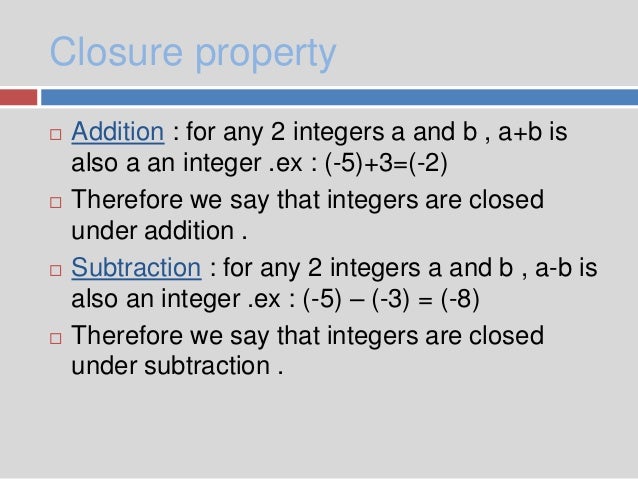


3 + 11 14 and 3 11 33 Notice that both 14 and 33 are real numbers. That means if a and b are real numbers, then a + b is a unique real number, and a b is a unique real number. On the other hand, if one divides 1 by 3, the calculator will display 0.333333, which is close, but not exact. Real numbers are closed under addition, subtraction, and multiplication. Nevertheless, if one subtracts a larger number from a smaller number, the calculator will complete the operation and display the negative number which results. Inexpensive, four-function calculators rarely allow one to use negative numbers as inputs. For example, one can say that the set of three-by-three matrices is closed with respect to addition.Ĭlosure, or the lack of it, can be of practical concern, too. It can be applied to sets of rigid motions in the plane, to vectors, to matrices, and to other things. When the Pythagoreans discovered that the square root of 2 was not rational, they had discovered that the rationals were not closed with respect to taking roots.Īlthough closure is usually thought of as a property of sets of ordinary numbers, the concept can be applied to other kinds of mathematical elements. Without extending the set of real numbers to include imaginary numbers, one cannot solve an equation such as x 2 + 1= 0, contrary to the fundamental theorem of algebra.Ĭlosure can be associated with operations on single numbers as well as operations between two numbers. For example, without augmenting the set of rational numbers with the irrationals, one cannot solve an equation such as x 2 = 2, which can arise from the use of the pythagorean theorem. The lack of closure is one reason for enlarging a set. Then, for example, the product of two negative numbers must be positive, and so on. Once one decides that the product of two positive numbers is positive, the other rules for multiplying and dividing various combinations of positive and negative numbers follow. In mathematical structure these two sets are indistinguishable except for one property, closure with respect to multiplication. Closure Property of Multiplication According to this property, if two integers a and b are multiplied then their resultant a × b is also an integer. Particularly interesting examples of closure are the positive and negative numbers. Similarly one knows that the set of polynomials is much like the set of integers because both sets are closed under addition, multiplication, negation, and subtraction, but are not closed under division.

Thus one knows that the set of natural numbers is less versatile than the set of integers because the latter is closed with respect to subtraction, but the former is not. These examples illustrate the Associative Properties.Knowing the operations for which a given set is closed helps one understand the nature of the set. You probably know this, but the terminology may be new to you. If we multiply three numbers, changing the grouping does not affect the product.

This is known as the Associative Property of Multiplication. When multiplying three numbers, changing the grouping of the numbers does not change the result. Example 4 Explain Closure Property under multiplication with the help of given integers 20 and (-5) Answer Find the product of given Integers 20 × (-5) (-100) Since the product of 20 and (-5) is equals to (-100) and (-100) is a negative integer, So, we can say that Integers. Suppose we want to find the value of the following expression:Ĭhanging the grouping of the numbers gives the same result. So, we can say that Integers are closed under Multiplication. The same principle holds true for multiplication as well. This is known as the Associative Property of Addition. When adding three numbers, changing the grouping of the numbers does not change the result. Closure property says that a set of numbers is closed under a certain operation if when that operation is performed on numbers from the set, we will get another number from the same set. (Remember that parentheses are grouping symbols that indicate which operations should be done first.) \begin17.īoth ways give the same result, as shown below. What about subtraction? Does order matter when we subtract numbers? Does 7 - 3 give the same result as 3 - 7?


 0 kommentar(er)
0 kommentar(er)
